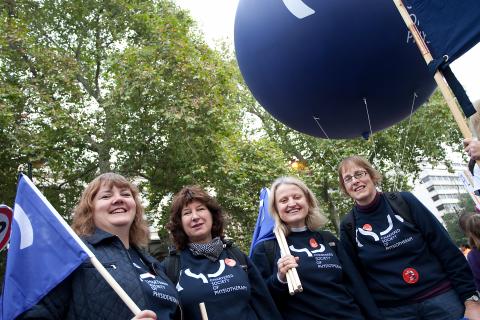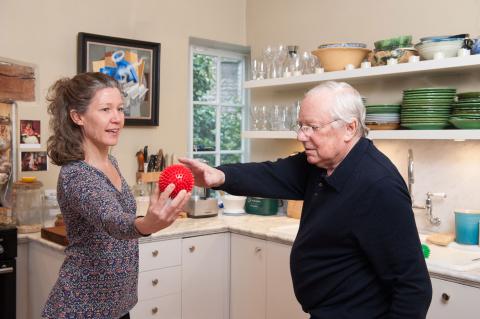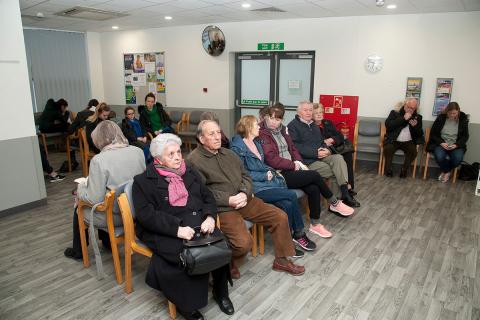The evidence behind the Stronger My Way initiative, insights into strengthening, and relevant published studies on strengthening.
Stronger My Way is built on insight from professionals and people living with long term conditions.
Below you’ll find the evidence behind the initiative, insights into strengthening and relevant published studies on strengthening.
Evidence for strengthening
Strength and balance quality markers: Supporting improvement through audit
- Public Health England with the National Falls Prevention Coordination Group. The intended audience for this document is both local commissioning and strategic leads in England with a remit for falls, bone health and healthy ageing and providers of strength and balance falls prevention exercise.
- In 2011, the UK physical activity guidelines were updated to include recommendations for muscle strengthening and balance & coordination (at least two sessions of relevant activities per week). However, monitoring and policy efforts remain focussed on aerobic activity. This study aimed to assess differences by gender and age in the a) prevalence of muscle strengthening and balance & co-ordination guidelines, and b) participation in guideline-specific activities.
Centre for Ageing Better: Raising the bar on strength and balance
Resistance training for older adults
- National Strength and Conditioning Association: position statement for resistance training for older adults and the benefits, program suggestions, and considerations specific to them
Muscle-strengthening Exercise Epidemiology: a New Frontier in Chronic Disease Prevention
- This current opinion provides an overview of the emerging discipline of muscle-strengthening exercise epidemiology.
Which strength and balance activities are safe and efficacious for individuals?
- Which strength and balance activities are safe and efficacious for individuals with specific challenges (osteoporosis, vertebral fractures, frailty, dementia)?: A Narrative review
How do muscle and bone strengthening and balance activities vary across the life course?
- How do muscle and bone strengthening and balance activities (MBSBA) vary across the life course, and are there particular ages where MBSBA are most important?
Muscle mass, strength, and physical performance predicting activities of daily living
- Muscle mass, strength, and physical performance predicting activities of daily living: a meta-analysis
Participation in strength and balance activities (Journal of Frailty, Sarcopenia and Falls)
- Enablers and barriers to older people’s participation in strength and balance activities: A review of reviews.
Physical activity – life course trajectories and patterns of strength in the UK
- An evidence review examining patterns of strength across the life course and to identify an optimum point at which to intervene to prevent decline, as well as identifying an appropriate measure that could be administered in any large scale surveys, epidemiological studies or interventions.
Perceptions of strengthening
Let's Talk About Strength Report
- The CSP’s Let’s Talk About Strength report carries findings from a year-long series of interviews, focus groups and other consultation with physio staff and people living with long term conditions.
Sport England measuring strength in Active Lives survey
- Why Sport England now measure muscle strength in Active Lives survey.
- The benefits of physical activity for people living with long term conditions are well established. However, the fear of increasing symptoms or worsening long term problems commonly stops people from moving more. Many healthcare professionals also feel unsure about what advice they should give to people living with symptomatic medical conditions.
National guidelines
WHO guidelines on physical activity and sedentary behaviour
- The WHO Guidelines on physical activity and sedentary behaviour provide evidence-based public health recommendations for children, adolescents, adults and older adults on the amount of physical activity (frequency, intensity and duration) required to offer significant health benefits and mitigate health risks.
UK Chief Medical Officers' physical activity guidelines
- UK Chief Medical Officers’ recommendations (2019) for physical activity in adults and older adults
- This report summarises a rapid evidence review of muscle and bone strengthening and balance activities (MBSBA) for general health benefits in adults and older adults by a working group advised by a UK Chief Medical Officers’ (CMOs) Expert Committee for muscle strength, bone health and balance. It makes suggestions for actions to implement the findings for the public, practitioners and policy makers.
Understanding health inequities
- NHS Race & Health Observatory: Ethnic Health Inequalities in the UK (infographic)
- The Health Foundation: Evidence hub
- MSK Health Equalities - report of roundtable
- King's Fund- Equity and endurance: how can we tackle health inequalities this time?
Health Equity in England: The Marmot Review 10 Years On
- This report has been produced by the Institute of Health Equity and commissioned by the Health Foundation to mark 10 years on from the landmark study Fair Society, Healthy Lives (The Marmot Review).
LGBT in Britain - Health Report
- Build your awareness and knowledge around the health and social disparities that many LGBTQIA+ people face. Stonewall LGBT in Britain: Health Reports.
Sport England: The journey to equity (blog)
The King’s Fund: Health inequalities in a nutshell
Public Health England: Physical activity: understanding and addressing inequalities
Mencap guide to health inequalities regarding people with a learning disability
ARMA guide to health inequalities
Tools for talking about strength
Top tips on how to talk about strength (CSP)
- Tips on how to talk about strengthening with your patients.
Advice on strength training for people with heart disease
- Association of Chartered Physiotherapists in Cardiovascular Rehabilitation: Advice on strength training for people with heart disease
- Exercise and able to track progress, reminders when to do exercises
Physical activity insights
Physical activity and long term health conditions resource packs
aimed at the sport and physical activity sector, health and care organisations and the health and care workforce
We Are Undefeatable - Insight pack: Health conditions and physical activity
- The impact of Covid 19 on physical activity levels among people living with health conditions
Evaluation of the Movement for All programme (2018 - 2021)
- This report summarises the work of the Richmond Group of Charities whose projects and partnerships are helping to establish where there are gaps in provision, what works to fill them and what we can all do differently in the future.
- Research reports and resources to help inform how we can make it #EasierToBeActive for people with long-term health conditions
Long Covid
- Find out what the signs and symptoms of Covid are, along with information on diagnosis, frequently asked questions and resources, and our updated rehabilitation standards.







































